Silicon Motion SM2263XT HMB SSD Preview
Performance Testing
Comparison Products
We have several next-generation SSDs at our disposal, and more are on the way. It's still too early to determine which product will rise to the top now that every manufacturer has 64-layer flash. Toshiba/WD and Intel/Micron have managed to increase performance with their latest 3D flash technologies. Meanwhile, Samsung's V-NAND advantage has shrunk, if not been eliminated.
The Silicon Motion SM2263XT without a native DRAM cache should be a low-performance product, but that's not what the results show. To get a better understanding of what the future holds, we've brought in competing SSDs with next-gen Toshiba and Samsung flash. The Samsung PM981 features 64-layer V-NAND while the MyDigitalSSD SBX uses Toshiba's 64-layer BiCS FLASH.
Products with the SM2263XT DRAM-less controller should fall on the lower end of the pricing scale, so we've also included other entry-level products, like the Intel 600p, MyDigitalSSD BPX, and Adata GAMMIX S10.
The products in our test pool allow us to compare the SM2263XT to current low-cost models and the next-generation products coming to market soon.
Sequential Read Performance
To read about our storage tests in-depth, please check out How We Test HDDs And SSDs. We cover four-corner testing on page six of our How We Test guide.

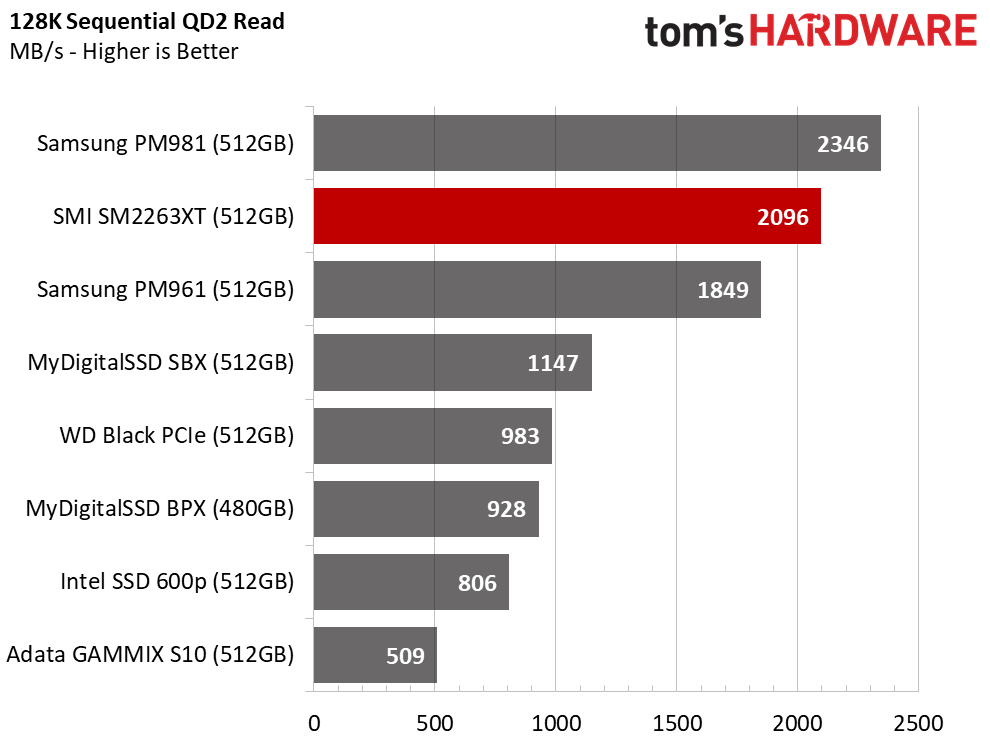
I bet you didn't see that coming. The SM2263XT outperforms all the other drives in this comparison at a queue depth (QD) of 1.
At QD2, the SMI SM2263XT only trails the Samsung PM981 that comes armed with the new Polaris controller and 64-layer V-NAND. SMI was able to build a controller that delivers exceptional sequential read performance at low queue depths. Until now, that level of performance was reserved for Samsung NVMe SSDs.
Get Tom's Hardware's best news and in-depth reviews, straight to your inbox.
Sequential Write Performance
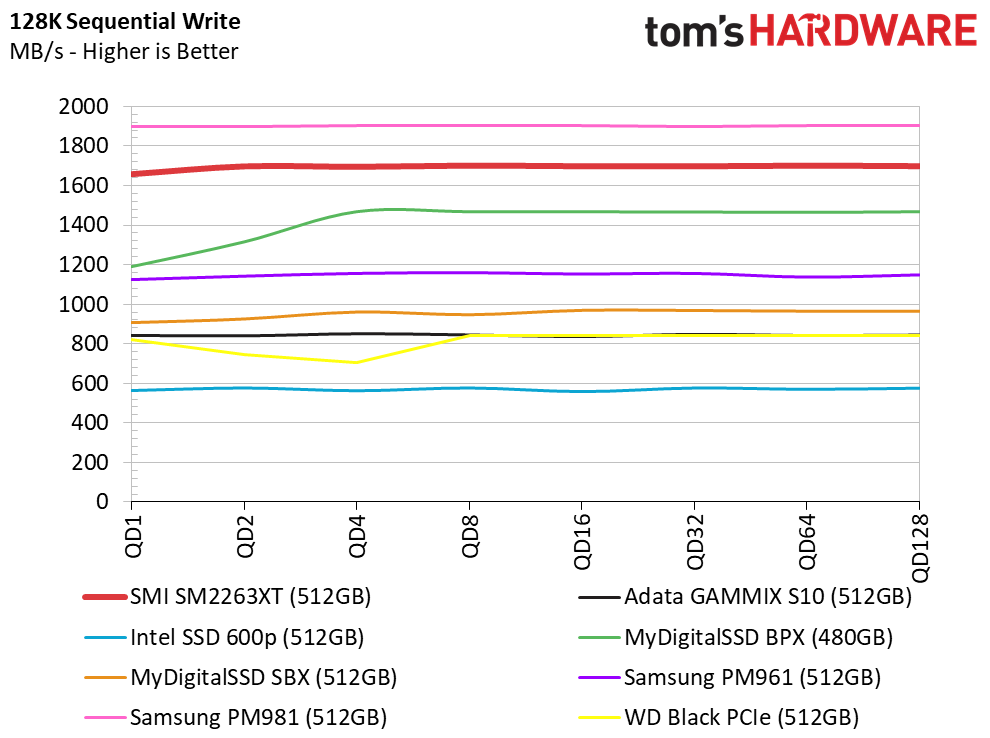
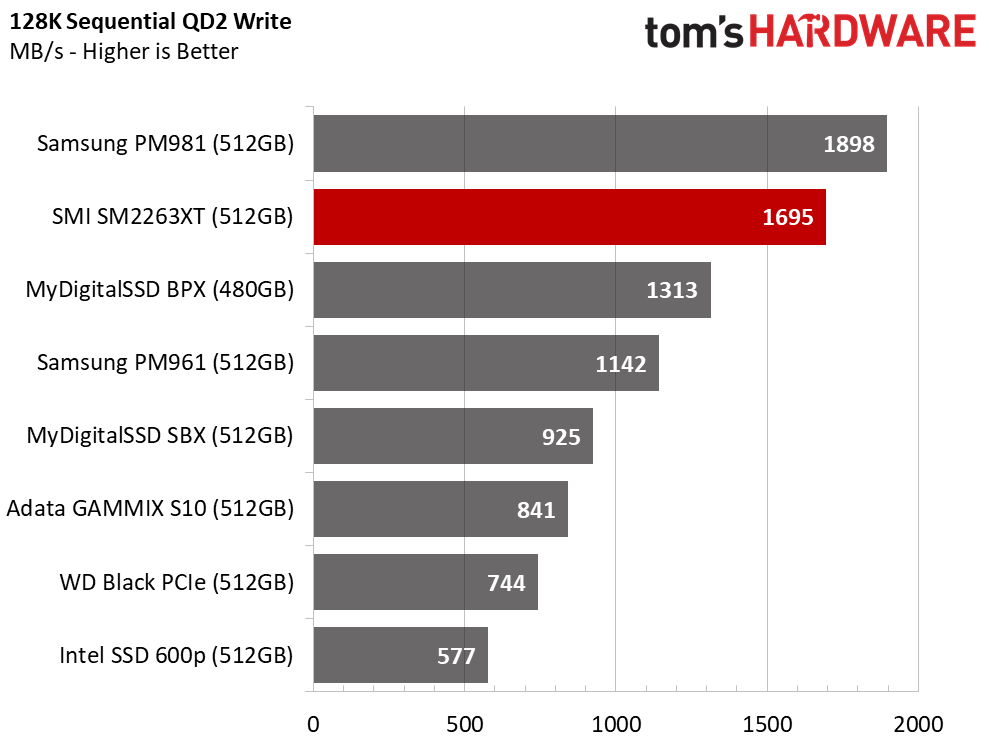
Low-cost products often have high sequential read performance but struggle with sequential writes. That's not the case today. The SMI SM2263XT delivers impressive sequential burst performance. We've tested previous-gen controllers from the company with the same caching technology that will come to market in the new controllers. The results have been very promising.
Sequential Sustained Write Performance
The 480GB SM2263XT SSD has 70GB of SLC cache that soaks up incoming write data when the drive is empty. The SLC cache is dynamic, though, meaning it shrinks as you fill the drive with data. After we saturate the cache, the native TLC performance spikes between 200 and 450 MB/s. The wide range is the result of the cache technology.
In the past, SMI controllers stored all the data in the SLC cache first, then later "folded" the data to the TLC. Other controller companies provide higher native TLC performance by bypassing the SLC cache when it is full and writing directly to the TLC NAND, but that technique also decreases endurance. We expected to see SMI use this "direct-to-die" technology, but the company chose to refine the folding method instead.
Random Read Performance
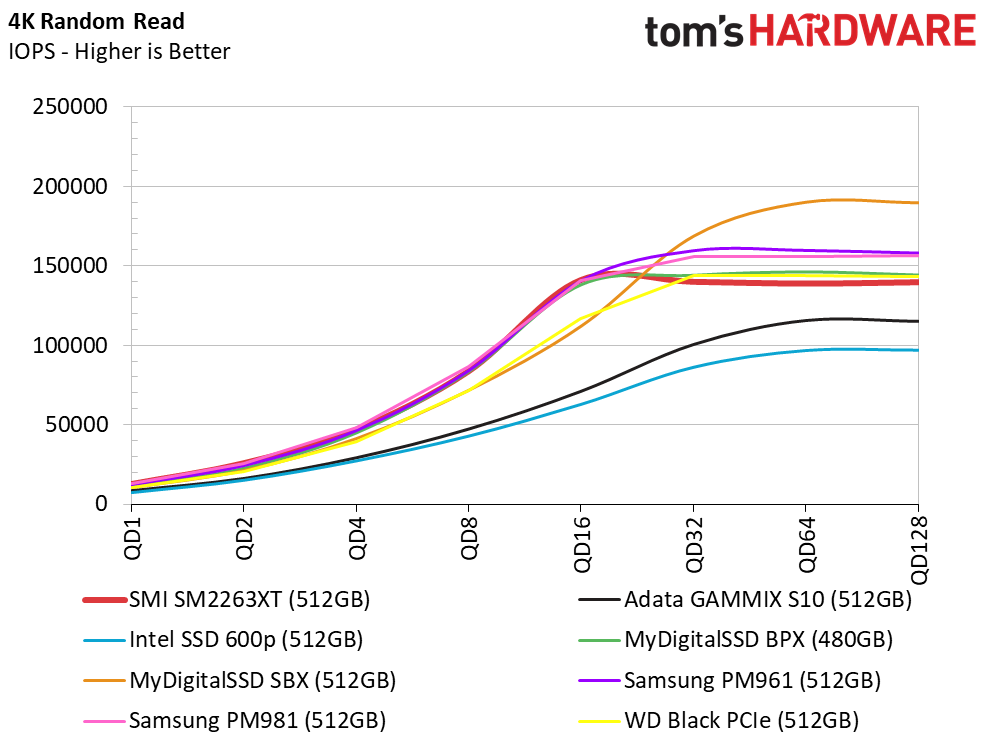
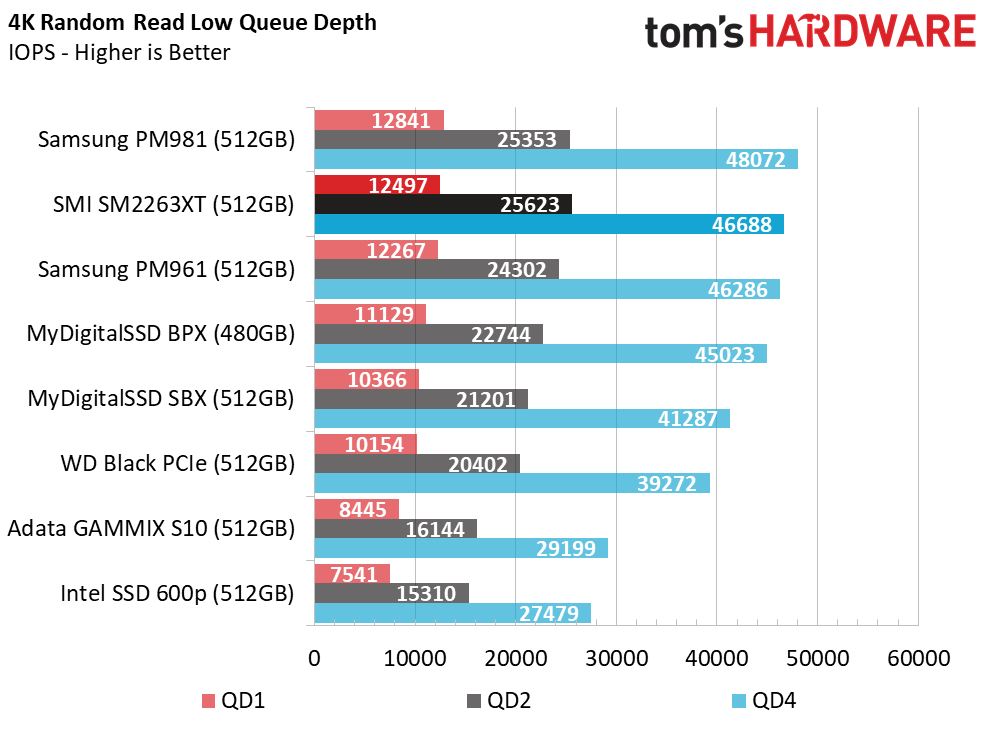
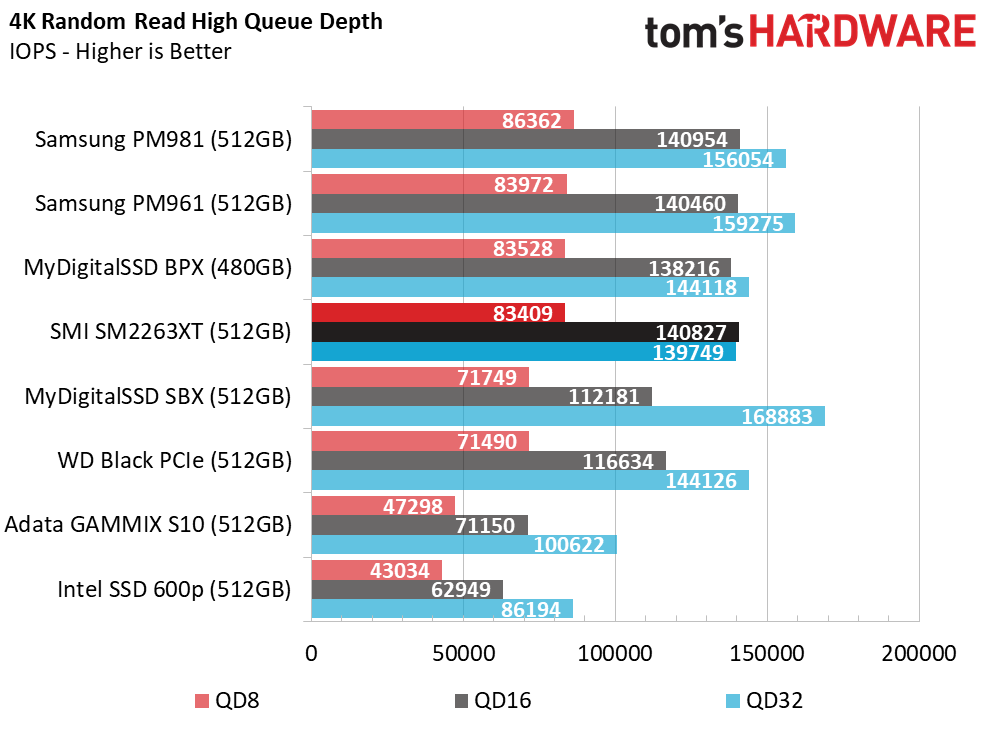
We've tested several DRAM-less SATA SSDs, and we were even the first to tackle the topic back in 2015. That experience taught us that random performance would always be lower for products without an integrated NAND buffer.
The early SM2263XT sample shatters our assumptions. Not only does the drive outperform some very popular products, but it also delivers nearly identical random read performance compared to Samsung's next-generation technology.
Random Write Performance



Random write performance is the only area where the SM2263XT can't match the high-performance Samsung NVMe drives. The low-QD random write performance is still very good, even by NVMe standards. The drive nearly reaches its maximum performance of 90,000 IOPS at QD2 with a single worker.
Even though the SM2263 and SM2263XT share the same on-paper rating, the SM2263 with a DRAM cache should deliver higher random write performance in our four-corner testing. We test with a larger test file than SMI uses to spec its drives, and in some cases, that makes a difference. SMI tells us that we might measure more random write performance when the SM2263 is ready.
70% Mixed Sequential Workload
We describe our mixed workload testing in detail here and describe our steady state tests here.


The SM2263XT delivers the second-best 128KB mixed sequential performance. The performance is very consistent through the queue depth range, but it's important to remember that these products are all serving the data directly out of the SLC cache.
70% Mixed Random Workload


The mixed random workload is the only synthetic test that exposes any sign of weakness with the DRAM-less HMB configuration. The SM2263XT still delivers better performance than most SATA SSDs, but it falls well short of what we see from other NVMe drives. We're not sure how to interpret this result after the encouraging random read and write results. The lower performance may be a result of the additional latency from reaching out to the system memory to update the tables, or it may simply be a firmware issue that SMI will need to correct.
PCMark 8 Real-World Software Performance
For details on our real-world software performance testing, please click here.






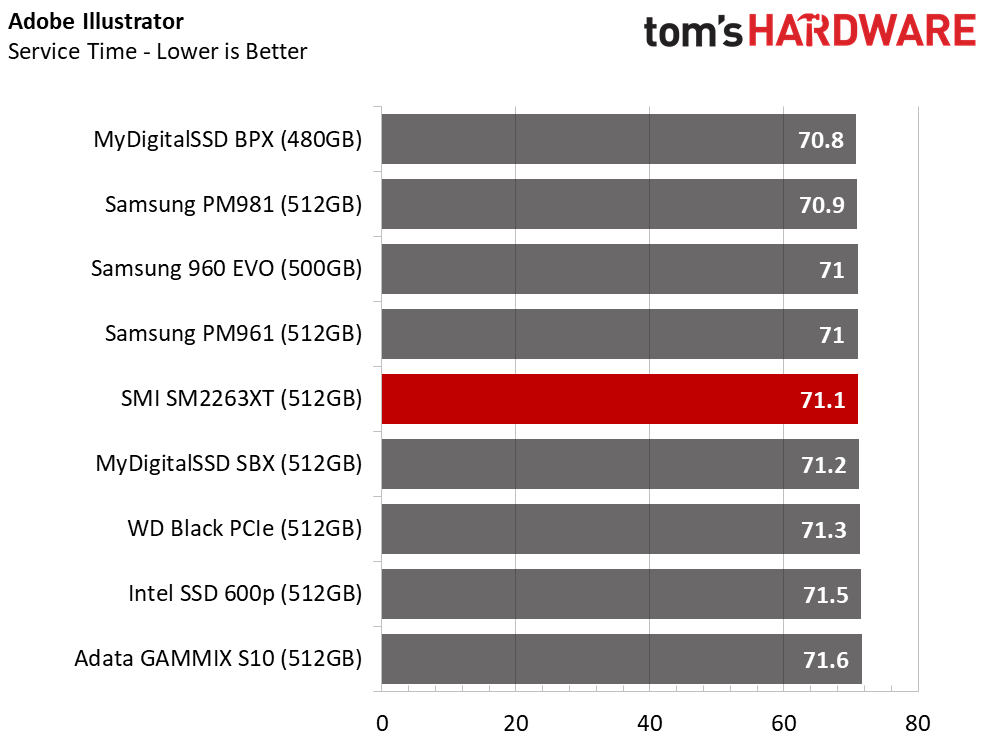



The SM2263XT performed much better than we expected in real-world applications. Silicon Motion has a competitive product with this controller and NAND combination. I'll be very happy if this is the future of low-cost NVMe.
Application Storage Bandwidth
Until now, entry-level NVMe SSDs like the Intel 600p only offered slightly better performance than premium SATA SSDs. The low random read performance hampered the user experience slightly during light workloads, but it fell well short of ripping through complex and heavy workloads. The SM263XT closes the gap between entry-level and premium NVMe products.
MORE: Best SSDs
MORE: How We Test HDDs And SSDs
MORE: All SSD Content

Chris Ramseyer was a senior contributing editor for Tom's Hardware. He tested and reviewed consumer storage.
-
takeshi7 DRAM-less SSDs should have to advertise that in giant letters on their box so that consumers know to avoid them. Those mixed I/O numbers are pathetic.Reply -
WyomingKnott Is it correct that a 1 TB SSD will have 1 GB of DRAM, or is that a typo, or did I read it wrong? Sounds like a pretty big lookup table.Reply -
alextheblue Reply
The new gen HMB-capable DRAMless SSDs (with FCU or later) are good enough for most consumers. Also most PC users buy OEM boxes... I'd much rather see users offered a machine with HMB DRAMless SSDs than HDDs or non-HMB DRAMless SSDs.20609574 said:DRAM-less SSDs should have to advertise that in giant letters on their box so that consumers know to avoid them. Those mixed I/O numbers are pathetic.
Heck, for secondary storage (mechanical drive replacement, media storage) even QLC drives will be OK, so long as they're well-designed.
Newer hardware and operating systems allow PCIe devices to flag data headed directly to system memory. Even though the system memory and PCIe bus are on opposite sides of the CPU, the flagged data passes through the processor without adding parasitic load.
That answers the first question that came to mind. What are the requirements for direct-to-memory flag support? Is it only a question of PCIe version x.xx and OS + SSD support? -
Lutfij Found the time to read through this review. Very well written Chris, keep up the good work!Reply




